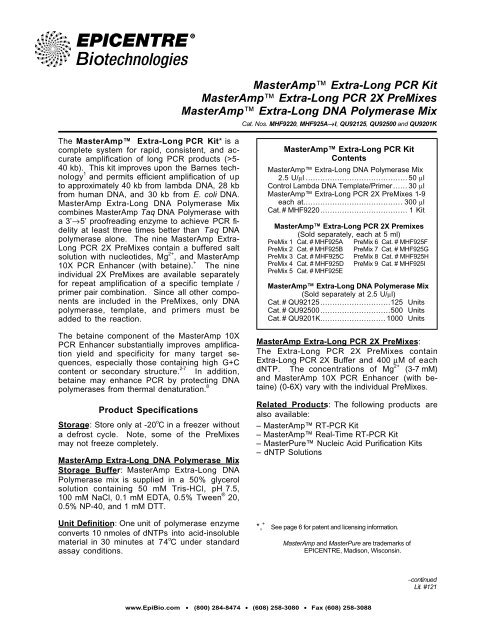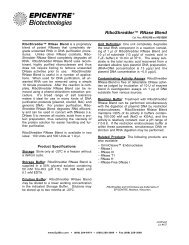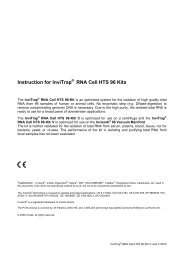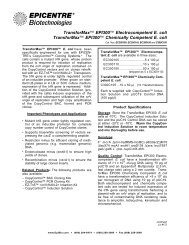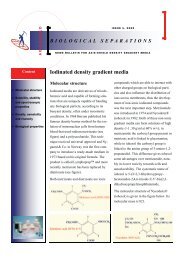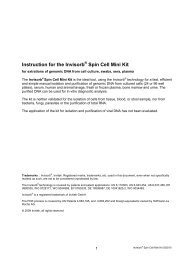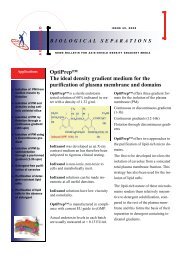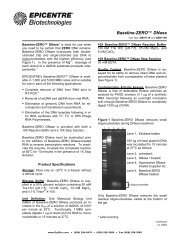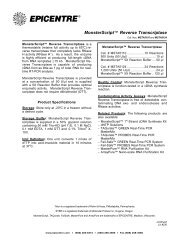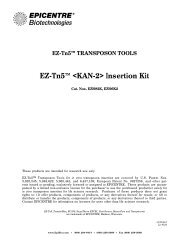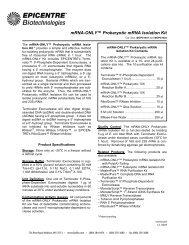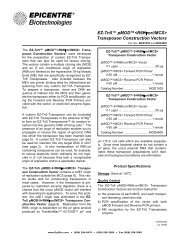Protocol for MasterAmp™ Extra-Long PCR Kit, MasterAmp™ Extra ...
Protocol for MasterAmp™ Extra-Long PCR Kit, MasterAmp™ Extra ...
Protocol for MasterAmp™ Extra-Long PCR Kit, MasterAmp™ Extra ...
- No tags were found...
You also want an ePaper? Increase the reach of your titles
YUMPU automatically turns print PDFs into web optimized ePapers that Google loves.
MasterAmp <strong>Extra</strong>-<strong>Long</strong> <strong>PCR</strong> <strong>Kit</strong>MasterAmp <strong>Extra</strong>-<strong>Long</strong> <strong>PCR</strong> 2X PreMixesMasterAmp <strong>Extra</strong>-<strong>Long</strong> DNA Polymerase MixCat. Nos. MHF9220, MHF925A→ I, QU92125, QU92500 and QU9201KThe MasterAmp <strong>Extra</strong>-<strong>Long</strong> <strong>PCR</strong> <strong>Kit</strong>* is acomplete system <strong>for</strong> rapid, consistent, and accurateamplification of long <strong>PCR</strong> products (>5-40 kb). This kit improves upon the Barnes technology1 and permits efficient amplification of upto approximately 40 kb from lambda DNA, 28 kbfrom human DNA, and 30 kb from E. coli DNA.MasterAmp <strong>Extra</strong>-<strong>Long</strong> DNA Polymerase Mixcombines MasterAmp Taq DNA Polymerase witha 3’→5’ proofreading enzyme to achieve <strong>PCR</strong> fidelityat least three times better than Taq DNApolymerase alone. The nine MasterAmp <strong>Extra</strong>-<strong>Long</strong> <strong>PCR</strong> 2X PreMixes contain a buffered saltsolution with nucleotides, Mg 2+ , and MasterAmp10X <strong>PCR</strong> Enhancer (with betaine). +The nineindividual 2X PreMixes are available separately<strong>for</strong> repeat amplification of a specific template /primer pair combination. Since all other componentsare included in the PreMixes, only DNApolymerase, template, and primers must beadded to the reaction.The betaine component of the MasterAmp 10X<strong>PCR</strong> Enhancer substantially improves amplificationyield and specificity <strong>for</strong> many target sequences,especially those containing high G+Ccontent or secondary structure. 2-7In addition,betaine may enhance <strong>PCR</strong> by protecting DNApolymerases from thermal denaturation. 8Product SpecificationsStorage: Store only at -20 o C in a freezer withouta defrost cycle. Note, some of the PreMixesmay not freeze completely.MasterAmp <strong>Extra</strong>-<strong>Long</strong> DNA Polymerase MixStorage Buffer: MasterAmp <strong>Extra</strong>-<strong>Long</strong> DNAPolymerase mix is supplied in a 50% glycerolsolution containing 50 mM Tris-HCl, pH 7.5,100 mM NaCl, 0.1 mM EDTA, 0.5% Tween ® 20,0.5% NP-40, and 1 mM DTT.Unit Definition: One unit of polymerase enzymeconverts 10 nmoles of dNTPs into acid-insolublematerial in 30 minutes at 74 o C under standardassay conditions.MasterAmp <strong>Extra</strong>-<strong>Long</strong> <strong>PCR</strong> <strong>Kit</strong>ContentsMasterAmp <strong>Extra</strong>-<strong>Long</strong> DNA Polymerase Mix2.5 U/µl .......................................... 50 µlControl Lambda DNA Template/Primer...... 30 µlMasterAmp <strong>Extra</strong>-<strong>Long</strong> <strong>PCR</strong> 2X PreMixes 1-9each at......................................... 300 µlCat. # MHF9220.................................... 1 <strong>Kit</strong>MasterAmp <strong>Extra</strong>-<strong>Long</strong> <strong>PCR</strong> 2X Premixes(Sold separately, each at 5 ml)PreMix 1 Cat. # MHF925A PreMix 6 Cat. # MHF925FPreMix 2 Cat. # MHF925B PreMix 7 Cat. # MHF925GPreMix 3 Cat. # MHF925C PreMix 8 Cat. # MHF925HPreMix 4 Cat. # MHF925D PreMix 9 Cat. # MHF925IPreMix 5 Cat. # MHF925EMasterAmp <strong>Extra</strong>-<strong>Long</strong> DNA Polymerase Mix(Sold separately at 2.5 U/µl)Cat. # QU92125.............................125 UnitsCat. # QU92500.............................500 UnitsCat. # QU9201K........................... 1000 UnitsMasterAmp <strong>Extra</strong>-<strong>Long</strong> <strong>PCR</strong> 2X PreMixes:The <strong>Extra</strong>-<strong>Long</strong> <strong>PCR</strong> 2X PreMixes contain<strong>Extra</strong>-<strong>Long</strong> <strong>PCR</strong> 2X Buffer and 400 µM of eachdNTP. The concentrations of Mg 2+ (3-7 mM)and MasterAmp 10X <strong>PCR</strong> Enhancer (with betaine)(0-6X) vary with the individual PreMixes.Related Products: The following products arealso available:– MasterAmp RT-<strong>PCR</strong> <strong>Kit</strong>– MasterAmp Real-Time RT-<strong>PCR</strong> <strong>Kit</strong>– MasterPure Nucleic Acid Purification <strong>Kit</strong>s– dNTP Solutions*, + See page 6 <strong>for</strong> patent and licensing in<strong>for</strong>mation.MasterAmp and MasterPure are trademarks ofEPICENTRE, Madison, Wisconsin.−continuedLit. #121www.EpiBio.com • (800) 284-8474 • (608) 258-3080 • Fax (608) 258-3088
EPICENTREMasterAmp <strong>Extra</strong>-<strong>Long</strong> <strong>PCR</strong> <strong>Kit</strong>MasterAmp <strong>Extra</strong>-<strong>Long</strong> <strong>PCR</strong> 2X PreMixesMasterAmp <strong>Extra</strong>-<strong>Long</strong> DNA Polymerase MixGeneral Considerations1. Template: The purity and integrity of the template DNA is very critical to the success of long <strong>PCR</strong>amplification. DNA prepared using standard isolation techniques is generally suitable <strong>for</strong> amplification.Nevertheless, numerous compounds inhibit amplification including ionic detergents, somegel loading dyes, phenol, and hemin. When purifying templates from agarose gels, minimize exposureto UV irradiation to prevent <strong>for</strong>mation of pyrimidine dimers. Assemble reactions in a cleanarea or use positive displacement pipettors with aerosol-barrier tips to minimize contamination riskfrom extraneous DNA templates. The optimal template amount <strong>for</strong> long <strong>PCR</strong> amplification may be4-5 times greater than standard <strong>PCR</strong>. For example, 1 ng of lambda DNA, 100 ng of E. coli DNAor 100-500 ng of human DNA is typically used <strong>for</strong> long <strong>PCR</strong>, though this may vary depending onthe source and quality of the template, as well as the length of the <strong>PCR</strong> product. 92. Primer Design: We recommend designing primers 20-30 bases in length containing 40-60%G+C residues with melting temperatures of 62-70 o C. Optimal primer pair annealing temperaturesshould be within 2-5 degrees of each other. Take care to design primers that do not <strong>for</strong>m hairpinloop structures or are self-complementary. The 5’ primer end may contain bases not complementaryto the template; however, the 3’ primer end must be complementary to the template. Primersof 30-35 bases in length are also commonly used <strong>for</strong> long <strong>PCR</strong> to achieve high specificity.3. Reaction Components: Mg 2+ concentration is particularly critical <strong>for</strong> amplification of a specifictarget. Excess Mg 2+ results in accumulation of nonspecific amplification products, while insufficientMg 2+ results in reduced yield of the desired of <strong>PCR</strong> product. The primer-to-template ratio isimportant <strong>for</strong> controlling the amplification specificity and efficiency; primer excess ensures the denaturedtemplate molecules bind to the primers instead the complementary DNA strand. 10Nevertheless,too much primer may lead to nonspecific product <strong>for</strong>mation or primer dimers. 200 mM(final concentration) of each dNTP (already included in the 2X <strong>Long</strong> <strong>PCR</strong> PreMixes), is sufficient<strong>for</strong> most <strong>PCR</strong> amplification. However, if desirable, additional dNTPs may be added to the reaction(dNTP stock solutions are available separately).4. Cycling Parameters: Many parameters influence both the specificity and efficiency of amplificationincluding the temperature and duration of denaturation, annealing, and extension, as well asramp speed and cycle number. Moderate denaturation temperatures and short incubation periodswill help maintain the integrity of long DNA templates. Programming an increase in extensiontime automatically <strong>for</strong> later cycles may also improve the yields of long amplification. 20-30 cyclesof amplification is typically sufficient, since amplification beyond ~10 12molecules may result innonspecific products. 8Additional variations such as use of a “hot start” 11 or touchdown/stepdown<strong>PCR</strong> 12,13 may also dramatically improve specificity and yield.5. DNA Polymerase: Amplification of sequences longer than 5 kb may be difficult with Taq DNApolymerase alone. There<strong>for</strong>e, inclusion of a small amount of 3’Æ5’ proofreading DNA polymeraseis commonly recommended <strong>for</strong> amplifications longer than 5 kb. Addition of larger DNA polymeraseamounts than <strong>for</strong> standard <strong>PCR</strong> may also be necessary to achieve longer amplification.6. Cosolvents: Cosolvents are typically used to improve <strong>PCR</strong> amplification. Glycerol, gelatin 14 ,DMSO 15 , and betaine 16 can improve long <strong>PCR</strong> amplification. Varying concentrations of Master-Amp 10X <strong>PCR</strong> Enhancer (with betaine) are already included in the MasterAmp <strong>Extra</strong>-<strong>Long</strong> <strong>PCR</strong>2X PreMixes <strong>for</strong> fast and convenient long <strong>PCR</strong> optimization.page 2
EPICENTREMasterAmp <strong>Extra</strong>-<strong>Long</strong> <strong>PCR</strong> <strong>Kit</strong>MasterAmp <strong>Extra</strong>-<strong>Long</strong> <strong>PCR</strong> 2X PreMixesMasterAmp <strong>Extra</strong>-<strong>Long</strong> DNA Polymerase MixSuggested <strong>PCR</strong> <strong>Protocol</strong>Assemble amplification reactions in a clean area and use positive displacement pipettors with aerosol-barriertips to minimize contamination risk from extraneous DNA templates.Assembly of Amplification ReactionsThe volumes listed below are <strong>for</strong> one amplification reaction containing a total reaction volume of50 ml. Assemble an appropriate amount of mix corresponding to the total number of reactions, andprepare nine tubes <strong>for</strong> each DNA template. (Preparation of an extra volume of mix may be useful tooffset pipetting losses.) Assemble the reactions at room temperature. Note, we have found “hotstart” to be unnecessary <strong>for</strong> most amplifications when using this kit.1. Thaw and thoroughly mix all of the reagents be<strong>for</strong>e dispensing. Combine the following:0.2-1 mM Forward Primer (final concentration)0.2-1 mM Reverse Primer (final concentration)x ml DNA template (4-5 times more DNA than standard <strong>PCR</strong> may be required)x ml sterile water to a reaction volume of 24 ml1 ml MasterAmp <strong>Extra</strong>-<strong>Long</strong> DNA Polymerase Mix25 ml Total reaction volume2. Aliquot 25 ml of each MasterAmp <strong>Extra</strong>-<strong>Long</strong> <strong>PCR</strong> 2X PreMix into an individual <strong>PCR</strong> tube.3. Add 25 ml of the template-primer-enzyme solution to the <strong>PCR</strong> tubes and mix well.4. Add mineral oil and centrifuge briefly if using a thermal cycler without a heated lid.5. Program the thermal cycler following the recommendations provided by the manufacturer.A suggested program is outlined below.a) Initially denature the template at 92-98 o C <strong>for</strong> 1-2 minutes.b) Per<strong>for</strong>m a 2- or 3-step cycling program, <strong>for</strong> 20-30 cycles as required:2-step cycling program:Denature at 92-98 o C <strong>for</strong> 0.5-1 minute.Anneal and Extend at 68-72 o C <strong>for</strong> 1 minute per kb of expected product.3-step cycling program:Denature at 92-98 o C <strong>for</strong> 0.5-1 minute.Anneal the primers at a temperature 2-5 o C below the T m of the primers <strong>for</strong> 0.5-1 minute.Extend the annealed primers at 68-72 o C <strong>for</strong> 1 minute per kb of expected product.c) Alternatively, extend <strong>for</strong> 1 minute per kb <strong>for</strong> the first 10-15 cycles, then lengthen the extensiontime 10 to 20 seconds <strong>for</strong> each of the next 10-15 cycles.6. After amplification, the samples may be kept at 4 o C overnight or frozen at -20 o C.page 3
EPICENTREMasterAmp <strong>Extra</strong>-<strong>Long</strong> <strong>PCR</strong> <strong>Kit</strong>MasterAmp <strong>Extra</strong>-<strong>Long</strong> <strong>PCR</strong> 2X PreMixesMasterAmp <strong>Extra</strong>-<strong>Long</strong> DNA Polymerase MixAmplification of the Control DNA TemplateThe control <strong>PCR</strong> amplification is designed to amplify a 20 kb region of lambda DNA in MasterAmp<strong>Extra</strong>-<strong>Long</strong> <strong>PCR</strong> 2X PreMixes 4 and 6. Users may also observe weak amplification with <strong>Extra</strong>-<strong>Long</strong><strong>PCR</strong> 2X PreMixes 1, 8 and 9.1. Thaw and thoroughly mix all of the reagents be<strong>for</strong>e dispensing. Combine the following at roomtemperature:21 ml sterile water3 ml control template & primers (1 ng DNA and 1 mM each primer, final concentration)1 ml MasterAmp <strong>Extra</strong>-<strong>Long</strong> DNA Polymerase Mix25 ml Total reaction volume2. Aliquot 25 ml of each MasterAmp <strong>Extra</strong>-<strong>Long</strong> <strong>PCR</strong> 2X PreMix into an individual <strong>PCR</strong> tube.3. Add 25 ml of the template-primer-enzyme solution to the <strong>PCR</strong> tubes and mix well.4. Add mineral oil and centrifuge briefly if using a thermal cycler without a heated lid.5. Denature the template at 94 o C <strong>for</strong> 1 minute.6. Per<strong>for</strong>m 20 cycles as follows:Denature at 98 o C <strong>for</strong> 20 seconds.Anneal the primers at 56 o C <strong>for</strong> 1 minute.Extend the annealed primers at 68 o C <strong>for</strong> 20 minutes.7. After amplification, the samples may be kept at 4 o C overnight or frozen at -20 o C.8. Analyze the amplification products by agarose gel electrophoresis.References:1. Barnes, W. M. (1994) Proc. Natl. Acad. Sci. USA 91, 2216.2. Schanke, J. T. and Grunenwald, H. L. (1997) Epicentre Forum 4 (1), 2.3. Grunenwald, H.L. and Schanke, J.T. (1997) Epicentre Forum 4 (1), 4.4. Mytelka, D.S. and Chamberlin, M.J. (1996) Nucl. Acids Res. 24, 2774.5. Henke, W. et al., (1997) Nucl. Acids Res. 25, 3957.6. Weissensteiner, T. and Lanchbury, J.S. (1996) BioTechniques 21, 1102.7. Rees, W.A. et al., (1993) Biochemistry 32, 137.8. Santoro, M.M. et al., (1992) Biochemistry 31, 5278.9. Roux, K.H. (1995) in: <strong>PCR</strong> Primer, Dieffenbach, C.W. and Dveksler, G.S. (eds.), CSH Press, New York, 53.10. Kolmodin, L.A. and Williams, J.F. (1997) in: <strong>PCR</strong> Cloning <strong>Protocol</strong>s, White, B.A. (ed.),Humana Press, Totowa, 6.11. Cha, R.S. and Thilly, W.G. (1995) in: <strong>PCR</strong> Primer, Dieffenbach, C.W. and Dveksler, G.S. (eds.),CSH Press, New York, 37.12. D’Aquila, R.T. et al., (1991) Nucl. Acids Res. 19, 3749.13. Don, R.H. et al., (1991) Nucl. Acids Res. 19, 4008.14. Ohler, L. and Rose, E. A. (1992) <strong>PCR</strong> Methods Appl. 2, 51.15. Cheng, S. (1995) in: <strong>PCR</strong> Strategies, Innis, M. A., Gelfand, D. H, and Sninsky, J. J. (eds.),Academic Press, San Diego, CA, 313.16. Hengen, P. N. (1997) Trends Biochem. Sci. 22, 225.page 4
EPICENTREMasterAmp <strong>Extra</strong>-<strong>Long</strong> <strong>PCR</strong> <strong>Kit</strong>MasterAmp <strong>Extra</strong>-<strong>Long</strong> <strong>PCR</strong> 2X PreMixesMasterAmp <strong>Extra</strong>-<strong>Long</strong> DNA Polymerase MixTroubleshooting Amplification ReactionsIf Little or No Desired <strong>PCR</strong> Product is Detected:1. Check template quantity and quality. Increase the amount of template DNA. Check templateDNA quality by agarose gel electrophoresis. Organic extraction followed by ethanol precipitationmay remove some inhibitors of amplification.2. Check DNA polymerase concentration. Increase the DNA polymerase concentration in incrementsof 0.5 units per 100 ml reaction.3. Lower annealing temperature. Lower the annealing temperature in 2 o C increments.4. Per<strong>for</strong>m hot start. 11 The assembly of amplification reactions at temperatures above the reactionannealing temperature improves both the yield and specificity. Assemble the reactions withoutthe primers or DNA polymerase; subsequently place the reactions in a thermal cycler heated to>80 o C, then add the appropriate amount of each primer or DNA polymerase and begin the cyclingprotocol. Alternatively, a modified hot start may be per<strong>for</strong>med in which reactions assembledon ice are added directly to a thermal cycler that is preheated to 92-98 o C.5. Per<strong>for</strong>m Touchdown (TD)/Stepdown (SD) <strong>PCR</strong>. 8,12,13 TD or SD <strong>PCR</strong> consists of a series of cyclesthat are per<strong>for</strong>med at decreasing annealing temperatures. This protocol favors amplification ofthe target at temperatures greater than or equal to the optimum annealing temperature, while enhancingtarget yield in later cycles at annealing temperatures below the T m of the reaction. Per<strong>for</strong>mthe initial series of cycles at an annealing temperature a few degrees above the calculatedT m of the primers; then lower the annealing temperature by 1-4 o C every other cycle to approximately10 o C below the calculated T m . A hot start must be per<strong>for</strong>med if using a TD or SD cyclingprotocol.6. Check the initial denaturation time or temperature. Lengthen or shorten denaturation time inincrements of 5 seconds. Increase or decrease denaturation temperature in increments of 1 o C.7. Increase extension time. Increase the extension time, generally one minute <strong>for</strong> every kilobaseof product.8. Increase number of cycles. Per<strong>for</strong>m additional cycles in increments of 5.9. Redesign primers. Design primers that have higher annealing temperatures and do not <strong>for</strong>mhairpin loops or anneal to one another.(Troubleshooting continued on next page)page 5
EPICENTREMasterAmp <strong>Extra</strong>-<strong>Long</strong> <strong>PCR</strong> <strong>Kit</strong>MasterAmp <strong>Extra</strong>-<strong>Long</strong> <strong>PCR</strong> 2X PreMixesMasterAmp <strong>Extra</strong>-<strong>Long</strong> DNA Polymerase MixIf Multiple Product Bands or Smear is Detected:1. Decrease concentration of reaction components. Decrease the amount of DNA template, DNApolymerase, or primers in the reaction mix.2. Increase annealing temperature. Increase the annealing temperature in 2 o C increments.3. Per<strong>for</strong>m hot start. 11 The assembly of amplification reactions at temperatures above the reactionannealing temperature improves both the yield and specificity. Assemble the reactions withoutthe primers or DNA polymerase; subsequently place the reactions in a thermal cycler heated to>80 o C, then add the appropriate amount of each primer or DNA polymerase and begin the cyclingprotocol. Alternatively, a modified hot start may be per<strong>for</strong>med in which reactions assembledon ice are added directly to a thermal cycler that is preheated to 92-98 o C.4. Per<strong>for</strong>m Touchdown (TD)/Stepdown (SD) <strong>PCR</strong>. 8,12,13 TD or SD <strong>PCR</strong> consists of a series of cyclesthat are per<strong>for</strong>med at decreasing annealing temperatures. This protocol favors amplification ofthe target at temperatures greater than or equal to the optimum annealing temperature, while enhancingtarget yield in later cycles at annealing temperatures below the T m of the reaction. Per<strong>for</strong>mthe initial series of cycles at an annealing temperature a few degrees above the calculatedT m of the primers; then lower the annealing temperature by 1-4 o C every other cycle to approximately10 o C below the calculated T m . A hot start must be per<strong>for</strong>med if using a TD or SD cyclingprotocol.5. Decrease number of cycles. Decrease number of cycles in increments of 5.6. Decrease extension time. Reduce the extension time in increments of 1 minute.7. Check primers <strong>for</strong> degradation. Check primer integrity by electrophoresis on a denaturingpolyacrylamide gel.8. Redesign primers. Design primers that have higher annealing temperatures and do not <strong>for</strong>mhairpin loops or anneal to one another.* Covered by U.S. Patent No. 5,436,149 and other patents issued or pending worldwide, owned by Takara Shuzo, Co., Ltd. and nonexclusivelylicensed to EPICENTRE.+ Use of betaine in DNA polymerase reactions, including, but not limited to use <strong>for</strong> <strong>PCR</strong> or DNA sequencing, is covered by U.S. Patent No.6,270,962, European Patent No. 0742838, German Patent No. DE4411588C1, and other patents or patent applications in the U.S. and othercountries that are either assigned or exclusively licensed to EPICENTRE. Purchase of a product from EPICENTRE that contains betaineand a thermostable DNA polymerase is accompanied by a limited non-exclusive license <strong>for</strong> the purchaser to use the purchased productsolely <strong>for</strong> life science research, whether the purchaser per<strong>for</strong>ms research in a not-<strong>for</strong>-profit or a <strong>for</strong>-profit organization. However, if theproduct does not contain a thermostable DNA polymerase in addition to betaine, all <strong>for</strong>-profit organizations require a license fromEPICENTRE in order to use betaine or a product that contains betaine in DNA polymerase reactions <strong>for</strong> research applications, and not<strong>for</strong>-profitorganizations require a license if the product, the research, or the result of the research is transferred to or obtained <strong>for</strong> or onbehalf of a <strong>for</strong>-profit organization. Licenses are also available to use betaine in DNA polymerase reactions <strong>for</strong> human or animaldiagnostics, screening, or other fields of use. Please contact EPICENTRE <strong>for</strong> in<strong>for</strong>mation related to such licenses.Notice to Purchasers: Limited LicenseUse of this product is covered by one or more of the following US patents and corresponding patent claims outside the US: 5,079,352,5,789,224, 5,618,711, 6,127,155 and claims outside the US corresponding to US Patent No. 4,889,818. The purchase of this product includesa limited, non-transferable immunity from suit under the <strong>for</strong>egoing patent claims <strong>for</strong> using only this amount of product <strong>for</strong> the purchaser’sown internal research. No right under any other patent claim (such as the patented 5’ Nuclease Process claims in US Patents Nos.5,210,015 and 5,487,972), no right to per<strong>for</strong>m any patented method and no right to per<strong>for</strong>m commercial services of any kind, including withoutlimitation reporting the results of purchaser's activities <strong>for</strong> a fee or other commercial consideration, is conveyed expressly, by implication,or by estoppel. This product is <strong>for</strong> research use only. Diagnostic uses under Roche patents require a separate license from Roche.Further in<strong>for</strong>mation on purchasing licenses may be obtained by contacting the Director of Licensing, Applied Biosystems, 850 Lincoln CentreDrive, Foster City, Cali<strong>for</strong>nia 94404, USA.page 6 10/08


